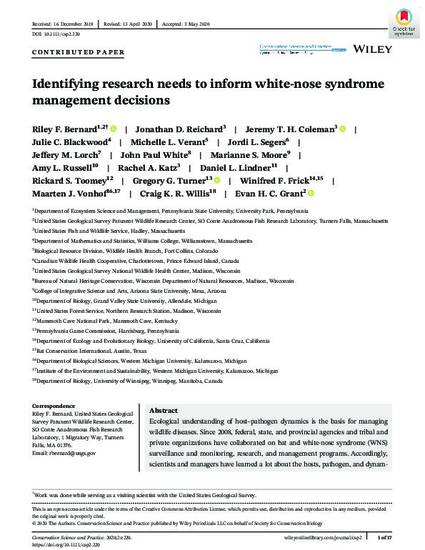
Article
Identifying research needs to inform white-nose syndrome management decisions
Conservation Science and Practice
(2020)
Abstract
Ecological understanding of host–pathogen dynamics is the basis for managing wildlife diseases. Since 2008, federal, state, and provincial agencies and tribal and private organizations have collaborated on bat and white-nose syndrome (WNS) surveillance and monitoring, research, and management programs. Accordingly, scientists and managers have learned a lot about the hosts, pathogen, and dynamics of WNS. However, effective mitigation measures to combat WNS remain elusive. Host–pathogen systems are complex, and identifying ecological research priorities to improve management, choosing among various actions, and deciding when to implement those actions can be challenging. Through a cross-disciplinary approach, a group of diverse subject matter experts created an influence diagram used to identify uncertainties and prioritize research needs for WNS management. Critical knowledge gaps were identified, particularly with respect to how WNS dynamics and impacts may differ among bat species. We highlight critical uncertainties and identify targets for WNS research. This tool can be used to maximize the likelihood of achieving bat conservation goals within the context and limitations of specific real-world scenarios.
Keywords
- bats,
- influence diagram,
- Pseudogymnoascus destructans,
- uncertainties,
- wildlife management
Disciplines
Publication Date
May 30, 2020
DOI
10.1111/csp2.220
Citation Information
Riley F. Bernard, Jonathan D. Reichard, Jeremy T. H. Coleman, Jullie C. Blackwood, et al.. "Identifying research needs to inform white-nose syndrome management decisions" Conservation Science and Practice Vol. 2 (2020) p. e220 Available at: http://works.bepress.com/amy_russell/35/
